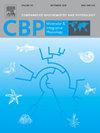Respiratory flow and tidal volume scale with body mass in sea turtles but not breath duration
IF 2.2
3区 生物学
Q4 BIOCHEMISTRY & MOLECULAR BIOLOGY
Comparative Biochemistry and Physiology A-Molecular & Integrative Physiology
Pub Date : 2025-04-04
DOI:10.1016/j.cbpa.2025.111855
引用次数: 0
Abstract
The ventilatory capacity of sea turtles is an important factor in their diving ability because they spend most of their time submerged. However, there is limited information on the relationship between the ventilatory capacity and body mass of sea turtles. To investigate the allometric scaling of the functional ventilatory capacity, we measured respiratory flow, tidal volume, and breath duration of spontaneous breaths in 40 sea turtles from 3 species (loggerhead, Caretta caretta; green, Chelonia mydas; hawksbill, Eretmochelys imbricata) of various body sizes (range: 0.7–120.6 kg) on land and in water. The results showed that the ventilatory capacity did not differ on land or in water. The respiratory flow and tidal volume increased with body mass with an allometric exponent of 0.76–0.80 and 0.87–0.89, respectively. In contrast, the breath duration and the ratio of tidal volume to the maximum lung volume were constant. These results suggest that sea turtles increase respiratory flow by increasing tidal volume with increasing body mass rather than prolonging breath duration, which may allow them to reduce the surface interval to breathe. This study improves the understanding of the ventilatory capacity of sea turtles.

海龟的呼吸流量和潮气量随体重变化,但与呼吸持续时间无关。
海龟的通气能力是影响其潜水能力的重要因素,因为它们大部分时间都在水下度过。然而,关于海龟的通气量和体重之间的关系的信息有限。为了研究功能通气量的异速标度,我们测量了3种海龟(赤蠵龟、赤蠵龟和赤蠵龟)的呼吸流量、潮气量和自主呼吸的呼吸持续时间。绿色,Chelonia mydas;在陆地和水中,身体大小不同(范围:0.7-120.6 kg)的玳瑁(Eretmochelys brbricata)。结果表明,陆地和水中的通风量没有差异。呼吸流量和潮气量随体重增加而增加,异速生长指数分别为0.76 ~ 0.80和0.87 ~ 0.89。相比之下,呼吸持续时间和潮气量与最大肺容积之比是恒定的。这些结果表明,海龟增加呼吸流量的方式是随着体重的增加而增加潮汐量,而不是延长呼吸时间,这可能使它们减少了呼吸的水面间隔。本研究提高了对海龟通气量的认识。
本文章由计算机程序翻译,如有差异,请以英文原文为准。
求助全文
约1分钟内获得全文
求助全文
来源期刊
CiteScore
5.00
自引率
4.30%
发文量
155
审稿时长
3 months
期刊介绍:
Part A: Molecular & Integrative Physiology of Comparative Biochemistry and Physiology. This journal covers molecular, cellular, integrative, and ecological physiology. Topics include bioenergetics, circulation, development, excretion, ion regulation, endocrinology, neurobiology, nutrition, respiration, and thermal biology. Study on regulatory mechanisms at any level of organization such as signal transduction and cellular interaction and control of behavior are also published.

 求助内容:
求助内容: 应助结果提醒方式:
应助结果提醒方式:


